Jeremy T. Ringfield's Blog, page 419
July 15, 2024
Biden says ‘bullseye’ remark was mistake, but that Trump is guilty of worse rhetoric
Kevin Rector | (TNS) Los Angeles Times
President Joe Biden said in an interview with NBC’s Lester Holt on Monday that it was a “mistake” to say prior to the weekend assassination attempt on former President Donald Trump that it was “time to put Trump in the bullseye.”
However, Biden said he only meant that the nation’s focus should be on Trump and the “threat to democracy” he represents. He also said Trump has repeatedly engaged in worse rhetoric — including by “making fun of” and “joking about” the violent attack on Rep. Nancy Pelosi’s husband Paul at their home in San Francisco in 2022.
“I didn’t say crosshairs. I was talking about focus on,” Biden said of his remark.
“Focus on what he’s doing, focus on his policies, focus on the number of lies he told at the debate. I mean, there’s a whole range of things,” Biden said. “Look, I’m not the guy who said I want to be a dictator on day one. I’m not the guy that refused to accept the outcome of the election.”
“You can’t only love your country when you win,” Biden said. “And so the focus was on what he’s saying.”
Holt asked Biden if he has done “a little soul-searching” about things he’d said that could “incite people who are not balanced.”
“How do you talk about the threat to democracy, which is real, when a president says things like he says? Do you just not say anything because it might incite somebody?” Biden said.
“Look, I … have not engaged in that rhetoric. Now, my opponent has engaged in that rhetoric. He talks about there will be a bloodbath if he loses, talking about how he is going to forgive all those — actually, I guess suspend the sentences of — all those who were arrested and sentenced to go to jail because of what happened at the Capitol” on January 6.
He asked Holt if he remembered when Trump mocked the attack on Pelosi.
The interview was set to be aired in full Monday evening. Holt described it as the first in an “unscripted setting” since the assassination attempt on Trump at a campaign rally in Pennsylvania on Saturday.
The interview drew some political attention back to Biden on the first day of the Republican National Convention in Milwaukee, where Trump formally received the party’s nomination.
Biden previously spoke to the attack on Trump in remarks late Saturday, just hours after Trump was shot, when he said “everybody must condemn” political violence. On Sunday, he gave a prime-time national address from the Oval Office where he again condemned the violence and asked everyone, amid high passions, to “cool it down.”
His campaign has pulled down attack ads against Trump in the wake of the shooting. Still, critics on the right have latched onto previous campaign rhetoric denouncing Trump, including the “bullseye” comment, to suggest that Biden and Democrats more broadly were partially to blame for the shooting.
Monday’s interview, which was scheduled before the assassination attempt, also was Biden’s latest chance to project competence following his disastrous debate performance last month, which elevated concerns, including from within his own party, about his age and his ability to lead.
Biden is 81. Trump is 78.
Related ArticlesNational Politics | Who is JD Vance? Things to know about Donald Trump’s pick for vice president National Politics | Who is JD Vance? Things to know about Donald Trump’s pick for vice president National Politics | In wake of Trump shooting, calls come for Secret Service protection for RFK Jr. National Politics | After Trump rally shooting, conspiracy theories flood the internet, creating dangerous ‘spiral’ National Politics | Trump picks Sen. JD Vance of Ohio, a once-fierce critic turned loyal ally, as his GOP running mate Biden has been under an intense microscope since the June 27 debate, where he repeatedly lost his train of thought and failed to challenge Trump’s talking points and falsehoods. He sounded hoarse and came out stiff, and the performance heightened existing concerns for many about his age.
Biden rebuffed calls for him to bow out in the days after, saying he may not be a “young man” anymore but still knew how to do the job well.
Biden gave an interview to ABC’s George Stephanopoulos on July 5, where he dismissed his debate performance as a “bad episode” and rejected the idea that he had any serious health condition that would undermine his ability to do the job. He also rejected the idea of submitting to an independent medical evaluation, saying the job of the presidency presented him with a “cognitive test every single day” — which he said he is passing while also being out on the campaign trail.
On July 11, Biden held a nearly hour-long news conference where he answered a range of questions from the media, including around foreign policy. There, he sounded defiant and boasted of his track record getting legislation passed.
He called himself the “most qualified person to run for president,” and said he would defeat Trump in November. “I beat him once, and I will beat him again.”
_____
©2024 Los Angeles Times. Visit latimes.com. Distributed by Tribune Content Agency, LLC.
Pedestrian killed in Highway 1 collision
A woman died after being hit by a vehicle on Highway 1 near the Soberanes Canyon Trailhead on Friday night according to the California Highway Patrol.
The woman, who is not being identified until her next of kin have been notified, reportedly stepped in the path of a Ford F150 heading north on Highway 1 at about 5:18 p.m. The driver reported she was unable to avoid colliding with the pedestrian. The driver remained on scene, according to the CHP, and cooperated with the investigation. The pedestrian was pronounced dead at the scene. Alcohol and/or drugs are not believed to be a factor in this crash.
The driver of the car and her passenger were not injured.
Monterey Council will vote on term-limits, moving sewer fees to property tax bill
The Monterey City Council will vote on a potential ballot measure to create term limits for the mayor and council members.
During Tuesday’s meeting, the council will discuss the ballot measure which would include several other charter amendment changes including; term limits, gender-neutral terminology for elected officials, how new agenda measures are presented to the public, and clarifying language on how the city and the Monterey Public Library select department heads and officials.
The council started this discussion earlier this year in February to keep the city’s charter updated. The council was mostly in agreement on all of the measures, save for the term-limits. Councilmembers Ed Smith and Alan Haffa disagreed with setting any term limits at all, saying there were not very many people running for local government, and traditionally Monterey has had several mayors and council members who sat on the council for over a decade.
However, a majority of the council shared their enthusiasm for term limits and the potential for more diversity on the council. The measure is expected to pass.
Monterey city staff are also recommending that Monterey move forward with having sewer fees collected through Monterey One Water annually.
For the last year, Monterey One Water has been preparing cities for its decision to change its billing from a bi-monthly fee to an annual fee. This was proposed to be a cost-saving measure for Monterey One Water, by collecting fees through county property taxes. However, during the last Monterey One Water board of directors meeting, the board failed to meet the voting requirements to move forward with the decision.
Some cities, like Seaside and Pacific Grove, have opted to hold out and continue planning before making a decision.
Monterey staff are proposing that so much work has already been done to prepare for the city to make the change, and they should continue. However, the only caveat is that Monterey residents will continue to get a bi-monthly statement in the mail from Monterey One Water, even though they are paying sewage through their property taxes.
The Monterey City Council will meet at 4 p.m. and 7 p.m. Tuesday, at Monterey City Hall, 580 Pacific St. The meeting will be available via Zoom at https://monterey-org.zoomgov.com/j/1607729333
Salinas Rodeo set to be an action-packed weekend
SALINAS >> The 114th California Rodeo Salinas officially kicks off Thursday and the 17,000 seats at the Salinas Sports Complex are on-track to sell out on Friday. Current ticket sales indicate Saturday and Sunday could also sell out.
The schedule for this year’s rodeo is packed with bull riding, barrel racing, button mucking and more. Many events are set to sell-out, according to Rodeo Marketing Manager Mandy Linquist. The largest rodeo in California, this event has been a Salinas staple for decades.
“We are definitely steeped in tradition,” said Linquist. “We love having families come out generation after generation.” The high-attendance rate can be attributed to the “all-day entertainment” offered, said Linquist, as the Salinas Sports Complex gates are open from 3-11 p.m. until Sunday.
The festivities leading up to the rodeo have already begun, as the carnival opened last Friday and will be open until Sunday evening. The annual Kiddie Kapers parade was held Sunday and saw more than 1,200 children march through Salinas’ Main Street on floats, wagons, bikes and more. The parade was led by Grand Marshal Kelly Mata Navarro, a 12-year-old cancer survivor.
This past weekend, Saturday ticket sales were 1,000 seats up from last year’s rodeo. The Sunday show last year was also close to selling out, as is this year.
Linquist encourages community members to “hurry up and get their tickets” as many of this year’s spectacles will likely sell-out for the second year in a row. Wednesday’s Big Week events have all sold out, including a cowgirl luncheon and Extreme bull riding, which will unofficially kickoff the rodeo at 7 p.m. on Wednesday.
Attendees can anticipate fan-favorite events such as break-away roping, an event highlighting cowgirls and their roping skills. The event is “fast and fun to watch and everyone seems to like to watch that,” said Linquist.
The California Rodeo Stick Horse Race will take place Thursday at 4:30 p.m., with 3 to 8-year-old children riding their stick horses and competing for the first-place belt buckle. On Friday at 3:30 p.m., kids aged 6-13 will compete in a Dummy Roping contest.
Aside from the physical entertainment, this year’s rodeo will feature clowns, actors, music and more. Starting on Thursday and performing throughout the weekend, Austin Singley will perform as the Green Hat Clown. Singley is known for his Comedy Hypnosis Show.
For the first time, the cultural celebration Fiestas del Rodeo (Parties of the Rodeo) will take place on Sunday from 11-3 p.m. Folkloric dancers will perform, followed by Mariachi music. There will also be Escaramuza riders available for autographs before their rodeo performance later on Sunday.
For the second-year in a row, specialty act John Payne, the One Arm Bandit, will perform throughout the weekend with his longhorn cattle act.
As the rodeo has been a generational tradition amongst Salinas residents, the California Rodeo Heritage Museum will provide opportunities for community members to learn more about the history of the iconic event. Open daily throughout the weekend, the museum will detail the past of the rodeo through memorabilia including saddles, vintage Miss California Rodeo outfits, cowboy attire and more.
As a not-for-profit organization, the rodeo has been fundraising and donating proceeds to local organizations and community members for years. Last year, around $771,000 was donated to various community organizations. Approximately $47,000 went toward funding scholarships for local students, according to Linquist.
“We believe in trying to keep as much funding as possible in our community to generate that economic impact and make a lasting impact on students,” she said. “We hope (they) come back and volunteer or be active in their community.”
Tickets will be the same price in-person and online and can be bought at https://www.carodeo.com/p/tickets.
Restoration project on mile section of Carmel River gets $35M funding
CARMEL – Celebrating the successful funding of $35 million for the Rancho Cañada Floodplain Restoration Project on the Carmel River, federal, state, and local partners gathered Friday at Palo Corona’s Rancho Cañada Unit to mark the milestone which will further return a former golf course to nature.
“Today we mark a major investment in this land because it is going to be a major enhancement for our environment with this floodplain restoration project,” said Rep. Jimmy Panetta, D-Carmel Valley. “A project to restore the Carmel River in this special 1-mile section in its natural state so that it reconnects with its historic floodplain habitat.”
That reconnection will create a mosaic of resilient and self-sustaining habitats that provide refuge for sensitive wildlife species, such as steelhead and the California red-legged frog, and a restored park for the community.
Funding has now been secured to begin construction of the restoration project next summer. The project has received grant funding from several federal and state sources including $10 million from the National Fish and Wildlife Foundation’s National Coastal Resilience Fund, $6 million from the National Oceanic and Atmospheric Administration Office for Coastal Management, $13 million from the Wildlife Conservation Board, and $6 million from the California State Coastal Conservancy.
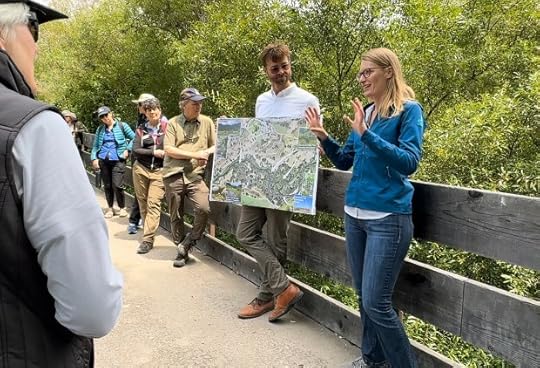 Katrina Harrison, McBain Associates, Applied River Sciences, Water Resources Engineer, explains aspects of the Rancho Cañada Floodplain Restoration Project on Friday, July 12, 2024. (James Herrera/Monterey Herald)
Katrina Harrison, McBain Associates, Applied River Sciences, Water Resources Engineer, explains aspects of the Rancho Cañada Floodplain Restoration Project on Friday, July 12, 2024. (James Herrera/Monterey Herald)“It takes a lot of people to make this happen,” said National Oceanic and Atmospheric Association Office for Coastal Management West Coast Regional Director Becky Smyth. “As a result, the Carmel River and this community are going to be much more resilient to the effects we’re seeing already from climate change. This river, this site, is a key part of NOAA’s fisheries south central coast steelhead recovery plan and it was as recent as last year that their five-year progress report said the Rancho Cañada site was a key project to enable better steelhead recovery, and here we are a year later with all the funding realized.”
The Monterey Peninsula Regional Park District acquired the 185-acre Rancho Cañada Golf Course property from the Trust for Public Land in April 2018, adding it as a unit of Palo Corona Regional Park and opening it for public use. The 36-hole former golf course was once the second largest water user on the Carmel River.
Monta Potter, Park District Board of Directors member said this project started with the acquisition of the golf course for the purpose of restoring it “into natural habitat, reestablishing terrestrial and rivering biotic communities and their corridors, protecting the region’s rich cultural heritage, providing educational research and recreational opportunities and protection of our precious surface and groundwater that was formerly used to irrigate the golf course.”
The Rancho Cañada Floodplain Restoration Project will be the first major restoration effort at the park, according to the Coastal Conservancy. It will entail about 3,200 linear feet of riprap to be removed to restore natural geomorphic processes such as scour, deposition and meander migration of the river. More than 650,000 cubic yards of sediment will be excavated, which will lower the existing disconnected floodplains so that annual inundation can recur. Backwater channels and alcoves will be created within the new floodplain surfaces to create areas that will inundate at winter base flows, recreating critical areas of quiet water that will be available to aquatic species. In-channel gravel will be added to raise the water surface elevation upstream, helping push water into new floodplains. Three former golf cart bridges will be retired, eliminating a safety hazard and providing additional space for the Carmel River to migrate. One new pedestrian bridge will be constructed as part of the project, which will be rated for emergency vehicle access to support safe public access to 4,500 acres of Palo Corona Regional Park and the future segment of the California Coastal Trail extending into Big Sur.
“The project is one part of an overall effort to restore the Carmel River watershed … it is a river in renewal,” said Amy Hutzel, executive officer of the State Coastal Conservancy.
Hutzel said the Coastal Conservancy has been a part of the San Clemente Dam removal project, the Palo Corona Regional Park Land acquisition, and the Rhana Creek Ranch acquisition, and the Carmel River Floodplain Restoration and Environmental Enhancement Project, and a number of smaller restoration projects and fish passage projects up the Carmel River watershed.
The Restoration Project complements the Big Sur Land Trust and Monterey County’s Carmel River FREE Project, another nature-based solution and floodplain restoration project downstream from the Rancho Cañada project area.
 The Rancho Cañada Floodplain Restoration Project will entail about 3,200 linear feet of riprap to be removed to restore natural geomorphic processes such as scour, deposition, and meander migration, of the river. More than 650,000 cubic yards of sediment will be excavated, which will lower the existing disconnected floodplains so that annual inundation can recur. The Carmel River on Friday, July 12, 2024. (James Herrera/Monterey Herald)
The Rancho Cañada Floodplain Restoration Project will entail about 3,200 linear feet of riprap to be removed to restore natural geomorphic processes such as scour, deposition, and meander migration, of the river. More than 650,000 cubic yards of sediment will be excavated, which will lower the existing disconnected floodplains so that annual inundation can recur. The Carmel River on Friday, July 12, 2024. (James Herrera/Monterey Herald)The Rancho Cañada Floodplain Restoration Project is particularly important for the federally threatened south-central California coast steelhead, according to the Coastal Conservancy. The Carmel River watershed contains over one hundred stream miles of high-quality salmonid spawning grounds, but virtually no floodplain. A natural floodplain is vital habitat for the survival of salmonid fish, as it serves as a nursery and rearing area to grow and mature before returning to the ocean.
The Restoration Project implements the recommendations of the Steelhead Recovery Plan, issued by the National Oceanic and Atmospheric Administration’s National Marine Fisheries Service.
The Park District Board hopes this project serves as a model for other communities and regions that may be interested in converting their golf courses or other human-created landscapes into natural habitat. It also hopes this project encourages other communities and regions to seek and develop strong, multifaceted partnerships to make these projects possible, said Potter.
The Rancho Cañada Floodplain Restoration Project partners include the Monterey Peninsula Regional Park District, California State Coastal Conservancy, U.S. Fish and Wildlife Service, National Oceanic and Atmospheric Administration’s National Marine Fisheries (NOAA Fisheries), California Department of Fish and Wildlife, Regional Water Quality Control Board, California State University Monterey Bay, Trust for Public Land, Monterey Peninsula Water Management District, Trout Unlimited, the Carmel River Task Force, and local tribes.
Summer of the shark: Aptos cove teems with sharp-toothed juveniles
APTOS — It has become the summer of the juvenile white shark at a small cove in the Aptos area this year with researchers estimating that numbers of the sleek ocean predator have reached an all-time high even after a decade of lofted trends.
Known among locals as “shark park,” members of the public, along with coastal experts and state officials, have spotted the young sharks arriving at New Brighton and Seacliff state beaches in droves since approximately early June, with the warm pockets of water acting as the perfect nursery for these growing fish.
“The juveniles, when they’re little, they kind of need this perfect Goldilocks zone of temperature,” said Salvador Jorgensen, a marine ecologist and assistant professor at California State University Monterey Bay. “Not too cold, not too hot.”
 A juvenile white shark seen swimming just off the coast near New Brighton State Beach. (O’Neill Yacht Charters – Contributed)
A juvenile white shark seen swimming just off the coast near New Brighton State Beach. (O’Neill Yacht Charters – Contributed)Ocean waters just off of the Santa Cruz County coastline have historically attracted adult white sharks, but that all changed, said Jorgensen, in 2014 when a massive marine heat wave sent temperatures in the Pacific Ocean soaring, making water in the cove just right.
“As the water temperatures are warming, and these warming events are more frequent due to climate change, all kinds of species are migrating away from the equator and heading toward the poles,” added Jorgensen. The relatively small Aptos enclave sits around 65 degrees during the summer while waters only a few miles south in Moss Landing have been measured in the high 50s, said Jorgensen.
Though numbers have fluctuated, Jorgensen said he and his research team, surveying the cove in a helicopter, once spotted 61 juveniles — the most since 2014 — swimming anywhere from 25 feet to a half mile offshore. He said numbers hit a peak in June and have begun tapering off and will continue to do so until September when most sharks move south.
State Parks spokesperson Gabe McKenna said the agency’s staff also noticed the uptick earlier this summer but also said sightings have slowed. State Parks officials have posted shark advisory signs at beaches in the area, but confirmed Wednesday that no aggressive shark behavior toward humans has been observed and there have been no attacks on humans.
“Just always be aware of your surroundings and check in with public safety and lifeguard staff, who are patrolling on the beaches, for current conditions,” said McKenna. “This isn’t abnormal. This has become more of the norm for this particular stretch of beach.”
This year’s especially high shark totals have also inspired an increase in opportunities to observe the normally elusive sea creatures up close. O’Neill Yacht Charters, which regularly takes eager ocean enthusiasts on tours up and down the county’s coastline with its 65-foot catamaran sailboat, has begun looping the toothy cove into its route.
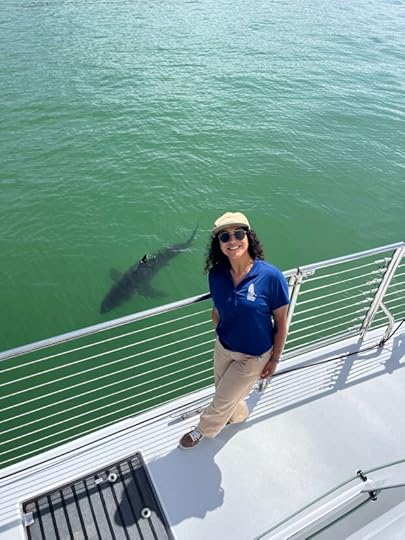 A worker with O’Neill Yacht Charters smiles as a juvenile white shark swims along the organization’s 65-foot catamaran boat. The sailing group has a “motors off” policy when it enters shark territory in Aptos. (O’Neill Yacht Charters – Contributed)
A worker with O’Neill Yacht Charters smiles as a juvenile white shark swims along the organization’s 65-foot catamaran boat. The sailing group has a “motors off” policy when it enters shark territory in Aptos. (O’Neill Yacht Charters – Contributed)“It offers a great vantage point for seeing the sharks right there and getting to be close to them, but like a healthy, respectful distance as well,” said Jenny Duckart, general manager of the charter group. “Everybody can feel comfortable and get a great experience out there.”
But the increased activity also heightens the risk of boats striking the sharks as they hover near the ocean’s surface for warmth — a concerning trend that Jorgensen’s team has observed this year. Duckart said the O’Neill charter implements a strict “motors off” policy once the catamaran approaches the cove and waits for the sharks to come to them.
“It’s their habitat,” said Duckart. “They’re the boss. We’re just there to witness it.”
But the white shark takeover has also come at a high cost for other marine animals sharing the territory. Jorgensen said many sea otters foraging along the coast have suffered accidental shark bites as the young hunters mistake the furry critters for blubbery seals. These otters end up stranded in the water or on beaches and the bites are often fatal, he added.
And while Jorgensen reiterated that the sharks have shown almost no interest in humans, the region has experienced tragedy in the past.
In 2020, local surfer and shaper Ben Kelly, 26, died after he was bitten in the leg by what was likely a 10 to 12-foot subadult white shark while surfing at Sand Dollar Beach, only a mile or two away from the Cement Ship in Seacliff. Kelly and other surfers in the water attempted to stop the bleeding with a surf leash, but the effort was futile.
“We have to be aware that we’re entering into, basically, a wild place that is intact with its top predators,” said Jorgensen. “Anytime we go in, there’s always a risk.”
Big change in Superbike standings after Laguna Seca weekend
LAGUNA SECA — Josh Herrin is a patient man.
Twelve races worth of his patience finally paid off at this weekend’s MotoAmerica Superbike Speedfest at WeatherTech Raceway Laguna Seca. Herrin captured his second win in three races and the victory made him points leader in the top-class Superbike championship with seven races remaining.
Herrin came into the weekend’s doubleheader at WeatherTech Raceway Laguna Seca as one of three riders within 10 points of Superbike championship leader Bobby Fong. It has been the closest title fight in MotoAmerica Superbike history and Herrin is happy to be in the hunt. He had been as low as seventh place in the championship earlier this season.
 (Mason Bloom — Herald Correspondent)
(Mason Bloom — Herald Correspondent)Points are awarded after races to the top 15 finishers, and the rider with the most points at the end of a season wins the championship. Race winners are awarded 25 points, second place 20 points, third place 16 points, and fifth gets 11, down to 15th getting one. The more races there are in a weekend, the more points a rider can earn.
Herrin took second place in Race 1 Saturday and opened a one-point lead in the championship standings. He found greater success in Sunday’s Race 2 and extended his new points lead to 15. It is a tenuous position, however. Less than 30 points now separate the top four riders with seven races left on the circuit.
The pressure of the points championship fight didn’t bother Herrin. In fact, it may have helped.
“I think it helps that (the championship is) tight because you don’t have time to really think about the lead or anything like that,” Herrin said after his Race 1 second-place finish. “If you’re in the lead by a lot then it’s more stressful because you’re thinking about it.”
Herrin started hot in Sunday’s race with a quick overtake in the first turn. A lap later Herrin undertook a brave lunge inside Cameron Petersen in the second turn, moving into second place. A daring final-corner move on Cameron Beaubier put Herrin into the race lead heading into the fifth lap.
Beaubier stuck close to Herrin but ultimately finished second.
“We’ve clawed our way back and the team really deserves this,” said Herrin. “It’s been 30 years since Ducati’s won a championship, and that just got me super motivated. It was just an amazing weekend.”
Herrin wasn’t the weekend’s only winner.
Beaubier led Race 1 from start to finish to capture the win after setting a WeatherTech Raceway Laguna Seca Superbike lap record in qualifying.
“(We) definitely got to go to work and put our heads down and stay on two wheels, that’s the number one thing right now,” said Beaubier. “It’s tough, don’t get me wrong, but it’s pretty cool being a part of this championship battle.”
Staying on two wheels in his second-place Race 2 finish advanced Beaubier from seventh to fifth in the championship, within 50 points of Herrin.
Race weekend also saw losers, starting with previous championship leader Fong.
Fong arrived hoping to widen his one-point lead over Jake Gagne. Fong started fifth in Race 1 after staying within a second of the session leaders in practice and both qualifying sessions.
 The top finishers at this weekend’s MotoAmerica Superbike Speedfest at WeatherTech Raceway Laguna Seca. (Mason Bloom — Herald Correspondent)
The top finishers at this weekend’s MotoAmerica Superbike Speedfest at WeatherTech Raceway Laguna Seca. (Mason Bloom — Herald Correspondent)Fong’s race ended cataclysmically on lap 10 when he lost control entering the third turn and was hurled into the gravel. He was in third place when he crashed and did not finish, moving him to fourth in the standings that day.
Fong fared better on Sunday, grabbing a fourth-place finish after crossing the finish line within a second of the winner. Saturday’s crash hurt Fong in the points standings, finishing the weekend in third place. Gagne treaded water after finishing fifth in Race 1 and 2 and exited the weekend where he started in the points standings – second place.
It was also bittersweet for Cameron Petersen. Like Fong, Petersen had sights on the championship lead. Petersen was in the top five through practice and qualifying. However, he jumped the start in Race 1 and the resulting five-second time penalty barred him from finishing second on Saturday. Petersen still claimed 16 points – 16 more than Sunday.
Petersen was fighting for the race lead on Sunday when mechanical issues forced him out after nine laps. Petersen came out of Laguna Seca fourth in the championship standings, four points behind Fong.
Meanwhile, racing action with championship point standing consequences also took place in other classes.
The Stock 1000 Championship saw a battle between Hayden Gillem and Jayson Uribe. Gillem left the weekend with the championship lead after his first- and third-place finishes bettered Uribe’s two second-places by one point. Gillem now has a seven-point lead over Uribe.
Another close battle occurred in the Supersport class between PJ Jacobsen and Mathew Scholtz. Jacobsen’s two wins bested Scholtz’s two second-place finishes by 10 points, shrinking Scholtz’s points lead to 18.
Mission King of the Baggers saw a championship leader swap. Kyle Wyman captured an easy victory and second-place finish to open a 14-point lead over Troy Herfoss, who had previously led by 13 points.
While Tyler O’Hara still leads the diverse Mission Super Hooligan class, two podiums for Cory West moved him into second in the standings.
MotoAmerica’s next stop is the Mid-Ohio Sports Car Course in Lexington, Ohio from Aug. 16-18.
Mason Bloom is a student journalist at Aptos High School.
Horoscopes July 15, 2024: Forest Whitaker, maintain a positive attitude
CELEBRITIES BORN ON THIS DAY: Tristan Wilds, 35; Lana Parrilla, 47; Jason Bonham, 58; Forest Whitaker, 63.
Happy Birthday: Listen, learn, pay attention and do your best to maintain a healthy lifestyle. Work to lower stress by eliminating people and pastimes that increase your stress level instead of helping you enjoy life. Stop talking; start incorporating what and who you want in your life, and transform your routine to maintain a positive attitude. Embrace the life that brings you joy. Your numbers are 4, 9, 23, 26, 31, 37, 46.
ARIES (March 21-April 19): Take a moment to establish what you want and how to make things happen. Keep your intentions to yourself until you have details in place. Do whatever it takes to avoid emotional interference from anyone manipulating you. Make romance a priority. 3 stars
TAURUS (April 20-May 20): Don’t take anything for granted. Do your own thing and allow others the same privilege. Anger wastes time, and confronting issues will drag you down. Don’t implement a premature change; give yourself a chance to test different scenarios first. Be punctual and avoid paying a penalty. 3 stars
GEMINI (May 21-June 20): Learn through trial and error. Practice will reduce mishaps. Refuse to let excess cause you grief. Uncertainty is a warning to take a moment to consider your actions. Physical fitness will ease stress and help you see issues. 3 stars
CANCER (June 21-July 22): Set boundaries and maintain a healthy routine. Monitor what and who causes you stress, and sign up for self-help groups to help you redirect your energy to something that encourages a positive return. Avoid hasty decisions that affect your finances or take up valuable time. 5 stars
LEO (July 23-Aug. 22): Research, find opportunities and don’t feel pressured to move until you are comfortable. You’ll gain the most insight and pleasure from your steps to discover what’s possible. Listen carefully, let your imagination kick in and pursue only what feels comfortable and within reach. 2 stars
VIRGO (Aug. 23-Sept. 22): Resolve unfinished projects. Actively seek the help of those you can trust to support your efforts, not criticize your decisions. Avoid discussing emotional issues until you feel confident you can do so without getting angry or ruining a meaningful relationship. Choose peace over turmoil. 4 stars
LIBRA (Sept. 23-Oct. 22): Muscle through projects. Using your physical attributes to get things done will be satisfying and encourage you to be adventuresome. An opportunity to learn or distance yourself from situations dragging you down will clear your head and promote new beginnings. 3 stars
SCORPIO (Oct. 23-Nov. 21): Put your differences aside when dealing with friends, colleagues and family. Focus on what you want to accomplish, and you will put a dent in your to-do list. Don’t deny yourself the right to venture down a path that gives you a different perspective regarding what’s possible. 3 stars
SAGITTARIUS (Nov. 22-Dec. 21): Refuse to let situations fester. Speak your mind, embrace what and who brings you joy, and find your opportunities. A chance to make money using a gift you possess will open a passage to exciting prospects. Self-improvement projects will pay off and encourage a positive lifestyle change. 3 stars
CAPRICORN (Dec. 22-Jan. 19): Rethink your financial situation and how you use your attributes to pay your bills. Consider what’s trending or marketable, and let your entrepreneurial instincts kick in and lead the way. A networking function will change how you proceed. 4 stars
AQUARIUS (Jan. 20-Feb. 18): Refuse to let the changes others make deter you from following your heart and heading in a direction that excites you. Opportunity knocks, and it’s up to you to take control and make things happen. Don’t wait for someone to make the first move; forge ahead. 2 stars
PISCES (Feb. 19-March 20): Clear the way for new beginnings. Be innovative; structure your life to ensure you leave more time and space for what’s important. Social events, personal growth and overdue discussions will help you sort out the changes necessary to reach your goal. 5 stars
Birthday Baby: You are caring, helpful and creative. You are emotional and giving.
1 star: Avoid conflicts; work behind the scenes. 2 stars: You can accomplish, but don’t rely on others. 3 stars: Focus and you’ll reach your goals. 4 stars: Aim high; start new projects. 5 stars: Nothing can stop you; go for gold.
Visit Eugenialast.com, or join Eugenia on Twitter/Facebook/LinkedIn.
Want a link to your daily horoscope delivered directly to your inbox each weekday morning? Sign up for our free Coffee Break newsletter at mercurynews.com/newsletters or eastbaytimes.com/newsletters.
July 14, 2024
Floor fights, boos and a too-long kiss. How the dramatic and the bizarre define convention history
By Will Weissert, Associated Press
WASHINGTON (AP) — In 1948, the Republican and Democratic parties did something unthinkable in today’s climate of ferocious political animosity: They not only held their national conventions in the same city, but shared some of the props.
Both gathered in Philadelphia, largely because its Municipal Auditorium had already been fitted with the wiring needed for then-groundbreaking live convention coverage on national television.
Related ArticlesNational Politics | The RNC’s first day will still focus on the economy. Here’s what to know about Trump’s plans National Politics | When does a presumptive nominee become a nominee? Here’s how Donald Trump will make it official National Politics | America’s toxic political climate faces calls to ‘tone it down’ after assassination attempt on Trump National Politics | Trump shooting changes Biden’s strategy to revive 2024 campaign National Politics | A timeline of the assassination attempt on former President TrumpTo save money, Democrats asked Republicans to leave the American flags and bunting up to be reused at its event 17 days later. The GOP complied, though some items became faded and worn in the interval.
Like party comradery, the more informal way conventions were staged has evaporated. Once bare-knuckled showdowns to hammer out presidential nominees, modern gatherings have evolved into carefully scripted, made-for-TV events meant to showcase party unity.
Republicans are largely on track to deliver that as they nominate former President Donald Trump in Milwaukee this week. The Democratic convention could feature more drama when it opens on Aug. 19, given the bitter debate over whether President Joe Biden should stay atop the party’s ticket.
But even with conventions now choreographed down to tiny details, the unexpected can still happen. Here’s a look at the floor fights, street battles, and other memorable convention scenes that were uplifting, outlandish or just plain awkward:
Ted Cruz’s non-endorsementAs the last candidate Donald Trump defeated during the 2016 GOP primary, Texas Sen. Ted Cruz amassed enough delegates to address the party’s convention in Cleveland — but balked at endorsing his former rival.
Still smarting over Trump calling him “Lyin’ Ted,” mocking his wife Heidi Cruz’s appearance and suggesting that the senator’s Cuba-born father was involved in the assassination of John F. Kennedy, Cruz implored delegates to “vote your conscience.” It drew prolonged boos.
Cruz reversed himself and endorsed Trump that fall, and today is among his staunchest defenders. But, at the time, the vitriol was high enough that Heidi Cruz was led from the convention floor, just in case.
Clint Eastwood’s empty chairA head-scratching moment came in 2012, when Clint Eastwood addressed the Republican gathering in Tampa, Florida, with an empty chair standing in for then-President Barack Obama.
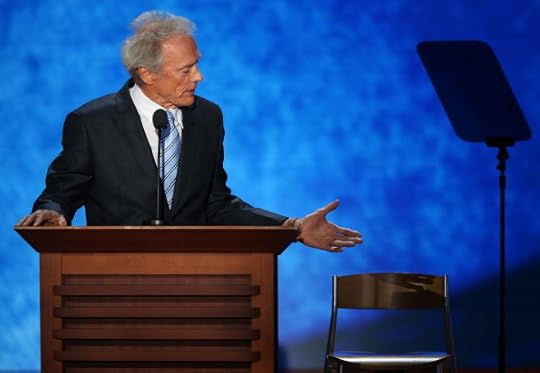 Actor Clint Eastwood speaks during the final day of the Republican National Convention at the Tampa Bay Times Forum on August 30, 2012 in Tampa, Florida. (Mark Wilson/Getty Images)
Actor Clint Eastwood speaks during the final day of the Republican National Convention at the Tampa Bay Times Forum on August 30, 2012 in Tampa, Florida. (Mark Wilson/Getty Images)The actor and director spent 12 minutes conversing with the piece of furniture, and even dodging barrages of imaginary obscenities from it.
“What do you mean shut up?” Eastwood crowed.
He also joked about then-Vice President Biden’s reputation for gaffes — launching criticisms that may prove prescient given current questions about whether Biden can handle a second term, following his disastrous debate performance.
“Of course, we all know Biden is the intellect of the Democratic party,” Eastwood told the chair. “Just kind of a grin, with a body behind it.”
‘Audacity of hope’The year 2004 was otherwise terrible for Democrats, President George W. Bush won reelection and Republicans retained control of Congress. But one bright spot came from Obama, then a little-known Illinois state senator, electrifying his party’s Boston convention.
Obama dubbed himself “a skinny kid with a funny name who believes that America has a place for him, too” and summed up his political philosophy as being built around “the audacity of hope.”
Gore’s extra-long kissAs he stepped on stage to deliver a speech accepting his party’s 2000 presidential nomination in Los Angeles, Al Gore embraced his wife Tipper and gave her a full-mouthed kiss, hanging on much longer than usual for a display of passion in public.
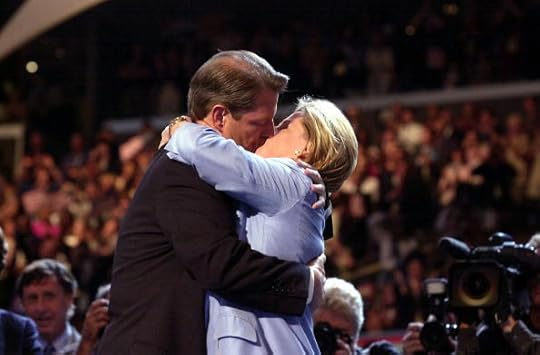 Democratic presidential candidate Al Gore kisses his wife Tipper after she introduced him to the Democratic National Convention at the Staples Center, August 17, 2000 in Los Angeles, California. (LUCY NICHOLSON/AFP via Getty Images)
Democratic presidential candidate Al Gore kisses his wife Tipper after she introduced him to the Democratic National Convention at the Staples Center, August 17, 2000 in Los Angeles, California. (LUCY NICHOLSON/AFP via Getty Images)The crow cheered, but the kiss eventually encompassed an uncomfortable three seconds of screen time.
Gore had been battling criticisms that he was too stiff during public appearances, which may have explained how hard he leaned in. Regardless, the smooch was remembered more than Gore’s speech.
He went on to narrowly lose that November to Bush. A decade later, the Gores separated after 40 years of marriage.
Women on the ticketAt the Democrats’ 1984 convention in San Francisco, presidential nominee Walter Mondale announced Geraldine Ferraro as his running mate, making her the first woman on a major presidential ticket. Ferraro declared, “America is the land where dreams can come true for all of us,” though she and Mondale went on to win just 13 electoral votes compared to President Ronald Reagan ‘s 525.
Twenty years later, Sen. John McCain chose Sarah Palin as his vice presidential candidate, and her speech at the Republican convention in St. Paul, Minnesota, was a hit, mixing the then-Alaska governor’s compelling personal story with humor and political punch. It gave McCain a boost, but he still lost to Obama.
At the 2016 Democratic convention in Philadelphia, Hillary Clinton became the first major party female presidential nominee, declaring, “When any barrier falls in America, for anyone, it clears the way for everyone.” She eventually lost to Trump.
Kamala Harris was the first woman on a winning ticket, accepting being Biden’s running mate during a mostly virtual convention last cycle — and now is some Democrats’ choice to replace Biden in this year’s presidential race.
Opposing the incumbentIn 1976, Reagan, then California’s governor, challenged President Gerald Ford from the right and touched off a bitter struggle at the GOP’s convention in Kansas City. Ford narrowly prevailed with 1,187 votes to 1,070, but lost that November to Democrat Jimmy Carter.
Four years later, at the Democratic convention in New York, Carter himself faced a floor challenge from Massachusetts Sen. Ted Kennedy, who badly trailed the president in delegates but tried to loosen rules on how they were pledged to vote. Tensions ran high and, though the change was defeated, Carter later lost to Reagan.
Eagleton’s 18-day vice presidential candidacyBiden facing increasing pressure to leave the race is without modern precedent at the top of a presidential ticket — but not when it comes to a nominee’s running mate.
Shortly after the 1972 Democratic convention in Miami, reports surfaced that Democratic presidential nominee George McGovern ’s vice presidential pick, Missouri Sen. Thomas Eagleton, had previously undergone electroshock therapy to treat depression.
A divided convention had prompted McGovern to tap Eagleton on its final day, after he was turned down by several alternatives. Eagleton therefore didn’t receive much vetting of his record, which might have surfaced the medical disclosures earlier.
Eagleton resigned after 18 days on the ticket and was replaced by Sargent Shriver. Incumbent Republican President Richard Nixon went on to win 49 out of 50 states that November.
Chaos in ChicagoAfter President Lyndon B. Johnson opted not to seek reelection and Robert F. Kennedy was assassinated, Vice President Hubert Humphrey secured the 1968 Democratic nomination at the party’s convention. But that was only after a raucous floor fight which ended with delegates defeating a peace platform seeking an end to the Vietnam war.
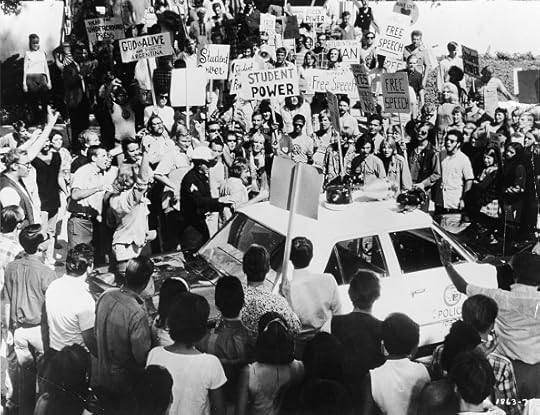 A police officer escorts a protestor to a squad car surrounded by dozens of anti-Vietnam War demonstrators outside the 1968 Democratic National Convention, Chicago, Illinois, August 1968. (Photo by Hulton Archive/Getty Images)
A police officer escorts a protestor to a squad car surrounded by dozens of anti-Vietnam War demonstrators outside the 1968 Democratic National Convention, Chicago, Illinois, August 1968. (Photo by Hulton Archive/Getty Images)What happened at the convention was overshadowed by thousands of anti-war protesters who marched in the streets. Demonstrators were attacked by police, sparking such turmoil that the tear gas fired reached the 25th floor hotel suite where Humphrey was preparing for his appearance at a hotel five miles from the convention site.
The Democratic convention returns to Chicago in a few weeks, and widespread demonstrations are being planned to oppose the Biden administration’s support for Israel in its war with Hamas — leaving some to wonder whether a 1968 redux could be coming. With questions about Biden staying in the race still being raised, things inside the convention might get equally heated.
The RNC’s first day will still focus on the economy. Here’s what to know about Trump’s plans
By Josh Boak, Associated Press
WASHINGTON (AP) — Donald Trump goes into the Republican National Convention with bold promises about the U.S. economy, but he has sketched out notably few details about how his plans would actually work.
The convention’s first day is still expected to focus on the economy even after Saturday’s shooting at a Trump rally in Pennsylvania in which the former president was injured.
If the program goes ahead as planned, expect speakers to argue that Trump’s agenda of sweeping tariffs and lower taxes would jump-start the economy.
The former president says he wants tariffs on trade partners and no taxes on tips and would like to knock the corporate tax rate down a tick. The Republican platform also promises to “defeat” inflation and “quickly bring down all prices,” in addition to pumping out more oil, natural gas and coal.
 View of a Make America Great Again art installation in downtown Milwaukee, Wisconsin, on July 14, 2024, ahead of the 2024 Republican National Convention. (Photo by BRENDAN SMIALOWSKI/AFP via Getty Images)
View of a Make America Great Again art installation in downtown Milwaukee, Wisconsin, on July 14, 2024, ahead of the 2024 Republican National Convention. (Photo by BRENDAN SMIALOWSKI/AFP via Getty Images)The platform would address illegal immigration in part with the “largest deportation program in American history.” And Trump would also scrap President Joe Biden’s policies to develop the market for electric vehicles and renewable energy.
Democrats and several leading economists say the math shows that Trump’s ideas would cause an explosive bout of inflation, wallop the middle class and — by his extending his soon-to-expire tax cuts — heap another $5 trillion-plus onto the national debt.
Trump has released few hard numbers and no real policy language or legislative blueprints. Instead, his campaign is betting that voters care more about attitude than policy specifics.
The Associated Press sent the Trump campaign 20 basic questions in June to clarify his economic views and the campaign declined to answer any of them. Spokeswoman Karoline Leavitt insisted that Trump best speaks for himself and directed the AP to video clips of him.
By contrast, Biden has an exhaustive 188-page budget proposal that lays out his economic vision, even as his campaign had increasingly devolved before Saturday’s rally shooting into questions about his age and whether he should remain the nominee after a self-defeating June 27 debate.
A recent analysis by the Peterson Institute of International Economics showed that deporting 1.3 million workers would cause the size of the U.S. economy to shrink by 2.1%, essentially creating a recession.
Stephen Moore, an informal Trump adviser and economist at the Heritage Foundation, a conservative think tank, said Trump is unique in that he’s already been president and voters can judge him off his record in office.
“You want to know what he’s going to do in his second term, look at what he did in his first term,” Moore said.
Democrats have argued that Trump would be more extreme in his second term, using his own remarks to say he would put independent federal agencies under his direct control and use the federal government to settle scores with his perceived enemies. The Heritage Foundation’s Project 2025 blueprint is a template for what a second term would look like, they argue, a claim that Trump has disputed.
But Moore said he believes that Trump would be pragmatic in office and focus on the needs of business to drive economic growth.
“There is an idea that it’s going to be like slash and burn — I don’t think it’s going to be a radical agenda,” Moore said.
Some of Trump’s plans have gotten bipartisan backing. Both of Nevada’s senators, Jacky Rosen and Catherine Cortez Masto, are Democrats who would like to ban taxes on tips paid to workers, even as the Biden White House favors a higher minimum wage for tipped workers.
Companies do like Trump’s ideas to cut regulations and further lower the corporate tax rate from 21% to 20%. The tax rate had been 35% when he became president in 2017. Democrats, by comparison, want a 28% corporate tax rate in order to fund programs for the middle class and deficit reduction.
Related ArticlesNational Politics | Floor fights, boos and a too-long kiss. How the dramatic and the bizarre define convention history National Politics | When does a presumptive nominee become a nominee? Here’s how Donald Trump will make it official National Politics | America’s toxic political climate faces calls to ‘tone it down’ after assassination attempt on Trump National Politics | Trump shooting changes Biden’s strategy to revive 2024 campaign National Politics | A timeline of the assassination attempt on former President TrumpBut Trump has also floated huge tariffs that he says would protect U.S. manufacturing jobs. Biden preserved the tariffs on China that Trump introduced and went a step further by banning exports of advanced computer chips to China.
Companies generally dislike tariffs — which are taxes on imports — because they can raise costs, which are then likely borne by consumers. An analysis by the economists Kimberly Clausing and Mary Lovely found that Trump’s tariffs would cost a typical U.S. household $1,700 a year in what would effectively be a tax hike.
Trump’s tariff plans could worsen inflation as a result, even though the Republican says in videos that he would reduce inflation. It’s unclear how Trump would lower inflation, which peaked in 2022 at 9.1% and has since eased to 3% annually.
“The tariff issue is extremely important — and people are not paying enough attention to the magnitude of the Trump tariff policy, what the consequences would be,” said Clausing, a former Biden Treasury Department official and professor at the University of California, Los Angeles.
But tariffs might be more of a political winner than an economic strategy, according to a research paper earlier this year by the economists David Autor, Anne Beck, David Dorn and Gordon Hanson. The research found that the tariffs during Trump’s first term did not increase employment, but the tariffs did help Trump politically in the 2020 election in the industrial areas that lost jobs to China and other countries.
Clausing noted that Trump is proposing tariffs on more than $3 trillion of imports, a 10-fold increase over what he did in his first term. She noted that the tariffs could make it more expensive to bring in the raw materials that U.S. factories need while also raising prices for consumers already struggling with high inflation. She said she wants people to understand the risks Trump’s economic policies could pose before it’s too late.
““I think people will notice when everything gets wildly expensive,” she said. “This is going to be a huge disaster.”



